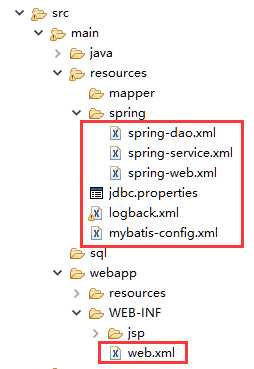搭建ssm框架,我们要分几步进行,把每个配置文件分开写,这样看上去一目了然,有利于后期的修改维护,对自己也可以记请每一步的内容和步骤,方便记忆
一.spring-dao.xml
二.jdbc. properties
三.mybatis-config.xml
四.spring-service.xml
五.spring-web.xml
六. web.xml
七.logback.xml
详细配置如下:
第一步:先在spring文件夹里新建spring-dao.xml文件,因为spring的配置太多了,这里我们分三层
dao service web
1.读入数据库连接的相关参数
2.配置数据连接池
3.配置连接属性,
4.配置c3p0,只配了几个常用的
5.配置SqlSessionFactory对象(mybatis)
6.扫描dao层接口,动态实现dao接口
spring-dao.xml
1 <?xml version="1.0" encoding="UTF-8"?>
2 <beans xmlns="http://www.springframework.org/schema/beans"
3 xmlns:xsi="http://www.w3.org/2001/XMLSchema-instance" xmlns:context="http://www.springframework.org/schema/context"
4 xsi:schemaLocation="http://www.springframework.org/schema/beans http://www.springframework.org/schema/beans/spring-beans.xsd http://www.springframework.org/schema/context http://www.springframework.org/schema/context/spring-context.xsd">
5 <!-- 配置整合mybatis过程 -->
6 <!-- 1.配置数据库相关参数properties的属性:${url} -->
7 <context:property-placeholder location="classpath:jdbc.properties" />
8
9 <!-- 2.数据库连接池 -->
10 <bean id="dataSource" class="com.mchange.v2.c3p0.ComboPooledDataSource">
11 <!-- 配置连接池属性 -->
12 <property name="driverClass" value="${jdbc.driver}" />
13 <property name="jdbcUrl" value="${jdbc.url}" />
14 <property name="user" value="${jdbc.username}" />
15 <property name="password" value="${jdbc.password}" />
16
17 <!-- c3p0连接池的私有属性 -->
18 <property name="maxPoolSize" value="30" />
19 <property name="minPoolSize" value="10" />
20 <!-- 关闭连接后不自动commit -->
21 <property name="autoCommitOnClose" value="false" />
22 <!-- 获取连接超时时间 -->
23 <property name="checkoutTimeout" value="10000" />
24 <!-- 当获取连接失败重试次数 -->
25 <property name="acquireRetryAttempts" value="2" />
26 </bean>
27
28 <!-- 3.配置SqlSessionFactory对象 -->
29 <bean id="sqlSessionFactory" class="org.mybatis.spring.SqlSessionFactoryBean">
30 <!-- 注入数据库连接池 -->
31 <property name="dataSource" ref="dataSource" />
32 <!-- 配置MyBaties全局配置文件:mybatis-config.xml -->
33 <property name="configLocation" value="classpath:mybatis-config.xml" />
34 <!-- 扫描entity包 使用别名 -->
35 <property name="typeAliasesPackage" value="com.soecode.lyf.entity" />
36 <!-- 扫描sql配置文件:mapper需要的xml文件 -->
37 <property name="mapperLocations" value="classpath:mapper/*.xml" />
38 </bean>
39
40 <!-- 4.配置扫描Dao接口包,动态实现Dao接口,注入到spring容器中 -->
41 <bean class="org.mybatis.spring.mapper.MapperScannerConfigurer">
42 <!-- 注入sqlSessionFactory -->
43 <property name="sqlSessionFactoryBeanName" value="sqlSessionFactory" />
44 <!-- 给出需要扫描Dao接口包 -->
45 <property name="basePackage" value="com.soecode.lyf.dao" />
46 </bean>
47 </beans>
jdbc. properties
jdbc.driver=com.mysql.jdbc.Driver jdbc.url=jdbc:mysql://localhost:3307/ssm?useUnicode=true&characterEncoding=utf8 jdbc.username=root jdbc.password=
因为这里用到mybatis,所以需要mybatis核心文件,在recourse文件夹里新建mybatis-configx.xml
1.使用自增主键
2.使用列别名
3.开启驼峰命名转换create_time ->createTime
mybatis-config.xml
<?xml version="1.0" encoding="UTF-8" ?>
<!DOCTYPE configuration
PUBLIC "-//mybatis.org//DTD Config 3.0//EN"
"http://mybatis.org/dtd/mybatis-3-config.dtd">
<configuration>
<!-- 配置全局属性 -->
<settings>
<!-- 使用jdbc的getGeneratedKeys获取数据库自增主键值 -->
<setting name="useGeneratedKeys" value="true" />
<!-- 使用列别名替换列名 默认:true -->
<setting name="useColumnLabel" value="true" />
<!-- 开启驼峰命名转换:Table{create_time} -> Entity{createTime} -->
<setting name="mapUnderscoreToCamelCase" value="true" />
</settings>
</configuration>
第二步:刚弄好到层,接下来service层。在spring文件夹创建spring-service.xml
1.扫描service包所有的@Service注解
2.配置事务管理器,把事物交有spring来完成
3.配置基于注解的声明事物,可以直接在方法上@Transaction
spring-service.xml
<?xml version="1.0" encoding="UTF-8"?>
<beans xmlns="http://www.springframework.org/schema/beans"
xmlns:xsi="http://www.w3.org/2001/XMLSchema-instance"
xmlns:context="http://www.springframework.org/schema/context"
xmlns:tx="http://www.springframework.org/schema/tx"
xsi:schemaLocation="http://www.springframework.org/schema/beans http://www.springframework.org/schema/beans/spring-beans.xsd http://www.springframework.org/schema/context http://www.springframework.org/schema/context/spring-context.xsd http://www.springframework.org/schema/tx http://www.springframework.org/schema/tx/spring-tx.xsd">
<!-- 扫描service包下所有使用注解的类型 -->
<context:component-scan base-package="com.soecode.lyf.service" />
<!-- 配置事务管理器 -->
<bean id="transactionManager"
class="org.springframework.jdbc.datasource.DataSourceTransactionManager">
<!-- 注入数据库连接池 -->
<property name="dataSource" ref="dataSource" />
</bean>
<!-- 配置基于注解的声明式事务 -->
<tx:annotation-driven transaction-manager="transactionManager" />
</beans>
第三步:配置web,在spring文件夹里新建spring-web.xml
1.开启SpringMVC注解模式,可以使用@RequestMapping,@PathBariable,@ResponseBady等
2.对静态资源的处理 ,如js,css,jsp等
3.配置警示牌、显示ViewResolver,例如controller中某个方法返回一个string类型的“login”,实际上回返回“WEB-INF/login.jsp”
4.扫描web层的@Controller注解
spring-web.xml
<?xml version="1.0" encoding="UTF-8"?>
<beans xmlns="http://www.springframework.org/schema/beans"
xmlns:xsi="http://www.w3.org/2001/XMLSchema-instance"
xmlns:context="http://www.springframework.org/schema/context"
xmlns:mvc="http://www.springframework.org/schema/mvc"
xsi:schemaLocation="http://www.springframework.org/schema/beans http://www.springframework.org/schema/beans/spring-beans.xsd http://www.springframework.org/schema/context http://www.springframework.org/schema/context/spring-context.xsd http://www.springframework.org/schema/mvc http://www.springframework.org/schema/mvc/spring-mvc-3.0.xsd">
<!-- 配置SpringMVC -->
<!-- 1.开启SpringMVC注解模式 -->
<!-- 简化配置: (1)自动注册DefaultAnootationHandlerMapping,AnotationMethodHandlerAdapter (2)提供一些列:数据绑定,数字和日期的format @NumberFormat, @DateTimeFormat, xml,json默认读写支持 -->
<mvc:annotation-driven />
<!-- 2.静态资源默认servlet配置 (1)加入对静态资源的处理:js,gif,png (2)允许使用"/"做整体映射 -->
<mvc:default-servlet-handler/>
<!-- 3.配置jsp 显示ViewResolver -->
<bean class="org.springframework.web.servlet.view.InternalResourceViewResolver">
<property name="viewClass" value="org.springframework.web.servlet.view.JstlView" />
<property name="prefix" value="/WEB-INF/jsp/" />
<property name="suffix" value=".jsp" />
</bean>
<!-- 4.扫描web相关的bean -->
<context:component-scan base-package="com.soecode.lyf.web" />
</beans>
第四步:最后就是修改web.xml文件
web.xml
<web-app xmlns="http://xmlns.jcp.org/xml/ns/javaee" xmlns:xsi="http://www.w3.org/2001/XMLSchema-instance"
xsi:schemaLocation="http://xmlns.jcp.org/xml/ns/javaee http://xmlns.jcp.org/xml/ns/javaee/web-app_3_1.xsd"
version="3.1" metadata-complete="true">
<!-- 如果是用mvn命令生成的xml,需要修改servlet版本为3.1 -->
<!-- 配置DispatcherServlet -->
<servlet>
<servlet-name>seckill-dispatcher</servlet-name>
<servlet-class>org.springframework.web.servlet.DispatcherServlet</servlet-class>
<!-- 配置springMVC需要加载的配置文件 spring-dao.xml,spring-service.xml,spring-web.xml Mybatis - > spring -> springmvc -->
<init-param>
<param-name>contextConfigLocation</param-name>
<param-value>classpath:spring/spring-*.xml</param-value>
</init-param>
</servlet>
<servlet-mapping>
<servlet-name>seckill-dispatcher</servlet-name>
<!-- 默认匹配所有的请求 -->
<url-pattern>/</url-pattern>
</servlet-mapping>
</web-app>
我们在项目中经常会使用到日志,若以这里还有配置日志xml,在resources文件夹里新建logback.xml
logback.xml
<?xml version="1.0" encoding="UTF-8"?>
<configuration debug="true">
<appender name="STDOUT" class="ch.qos.logback.core.ConsoleAppender">
<!-- encoders are by default assigned the type ch.qos.logback.classic.encoder.PatternLayoutEncoder -->
<encoder>
<pattern>%d{HH:mm:ss.SSS} [%thread] %-5level %logger{36} - %msg%n</pattern>
</encoder>
</appender>
<root level="debug">
<appender-ref ref="STDOUT" />
</root>
</configuration>
到目前为止,我们一共写了7个配置文件


